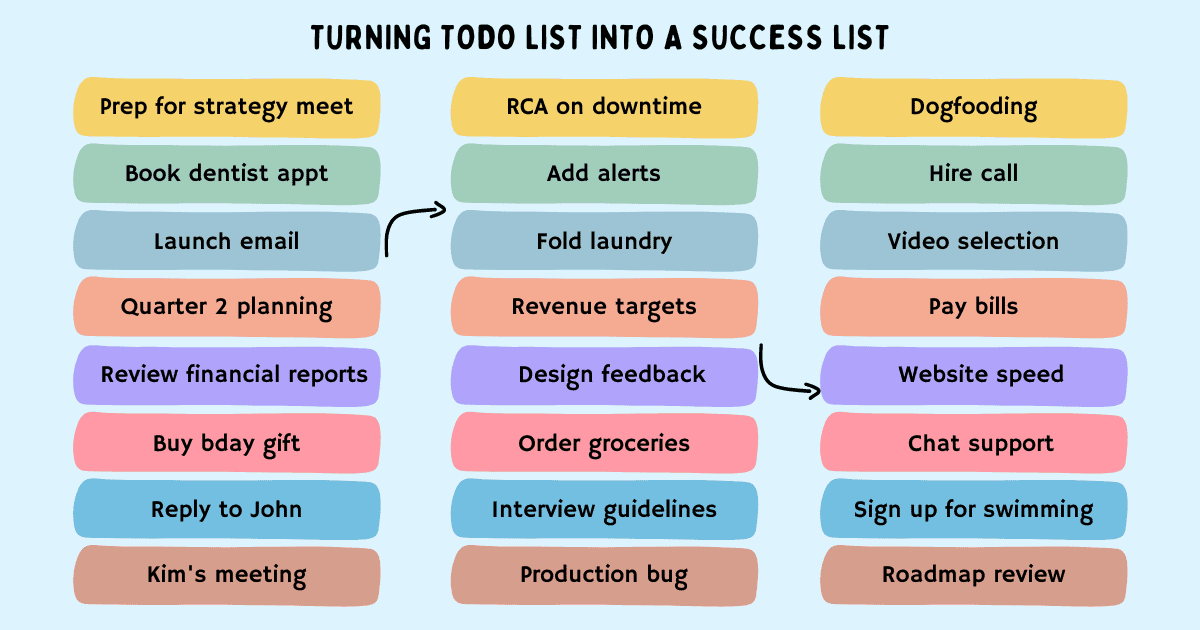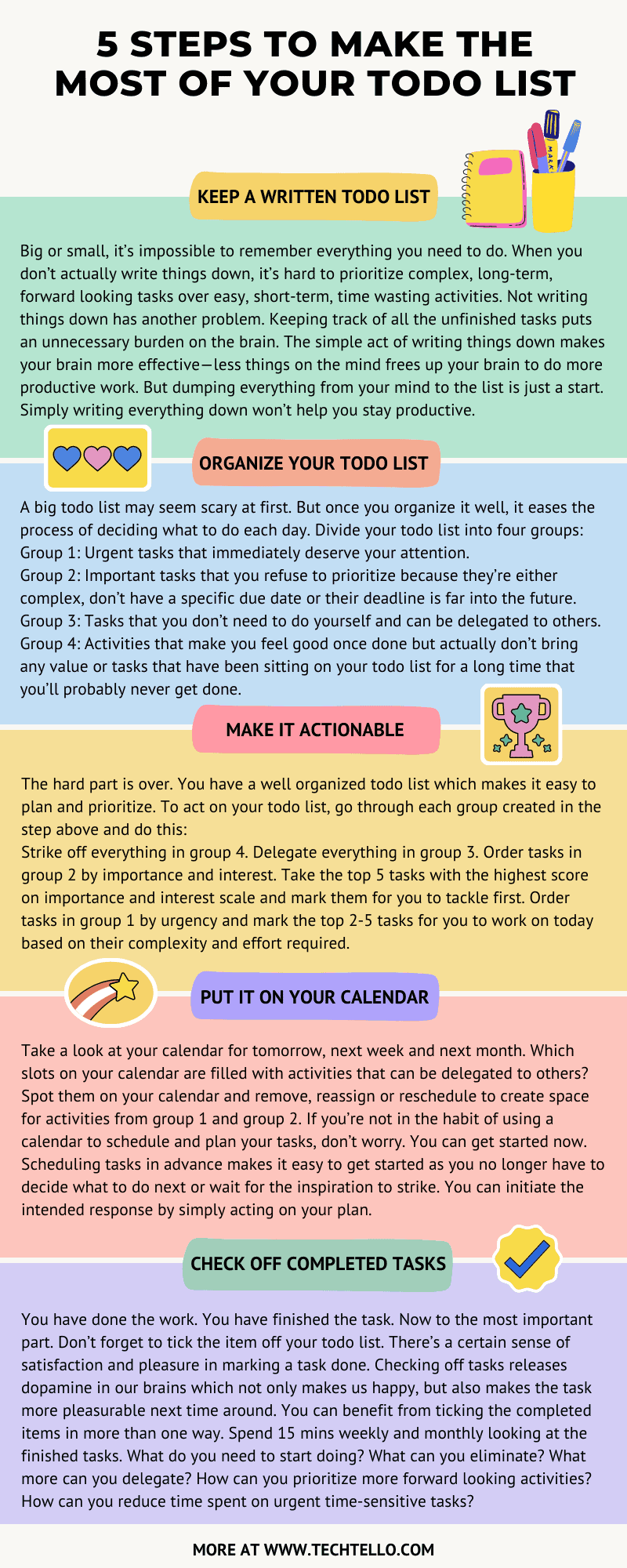How to Make the Most of Your Todo List

I got introduced to the concept of todo lists early in my career. The idea sounded simple and interesting, so I decided to give it a try.
I started putting everything on my mind into a todo list. It worked well initially. After all, I had only a few responsibilities. So putting them on a piece of paper and marking each one as I progressed didn’t require much planning and effort. I would glance at the list at the beginning of each day and tackle each task one by one.
Todo lists worked like a magic formula—writing tasks down ensured I didn’t miss anything, knowing I had it all in one place led to less stress and anxiety and the best part was the feeling of satisfaction from seeing those tick marks on my todo list which I believe kept me happy and motivated.
As I grew in my career, 5 tasks on my todo list turned into 20, 30, 40…and so on. Different types of responsibilities with different expectations both from work and at home was overwhelming. So I kept adding everything to my todo list and before I knew it, it was crammed with more things than I could accomplish.
A long list of things to do made it harder to pick something meaningful and valuable and get started on it. I would stare at the endless list, pick tasks at random and try to do as much as I could during the day. But in spite of working long hours, I felt defeated at the end of the day—my work was less impactful, more exhausting and I still had a ton of things on my todo list that kept crying for my attention.
Not accomplishing as much as I expected to was demotivating at first. But I wasn’t ready to give up. I knew the problem wasn’t my todo list but my process. So I decided to try a bunch of different strategies—some worked, others didn’t.
Here are the 5 practices to put your todo list to best use based on my experience.
Long hours spent checking off a to-do list and ending the day with a full trash can and a clean desk are not virtuous and have nothing to do with success. Instead of a to-do list, you need a success list—a list that is purposefully created around extraordinary results. To-do lists tend to be long; success lists are short. One pulls you in all directions; the other aims you in a specific direction. One is a disorganized directory and the other is an organized directive. If a list isn’t built around success, then that’s not where it takes you. If your to-do list contains everything, then it’s probably taking you everywhere but where you really want to go.
— Gary Keller, The One Thing
5 steps to make the most of your todo list
Keep a written todo list
Big or small, it’s impossible to remember everything you need to do. When you don’t actually write things down, it’s hard to prioritize complex, long-term, forward looking tasks over easy, short-term, time wasting activities.
Not writing things down has another problem. Keeping track of all the unfinished tasks puts an unnecessary burden on the brain. Your brain cycles that are better spent in completing a task are wasted in holding a mental list of all the things you need to do.
What makes it even worse is the Zeigarnik effect—thoughts of unfinished tasks keep popping up in your head right when you get down to work or are trying hard to focus.
These intrusive thoughts that take away your attention even for a split second makes it hard to concentrate and get any meaningful work done. Distractions from incomplete work prevents you from entering into a state of flow—which is when you are completely immersed in a task and the time seems to stand still. Flow minimizes distractions, prevents procrastination and leads to high performance and productivity.
Letting your brain continually remind you that you haven’t done something is actually quite unpleasant and it can even lead to stress, anxiety and burnout.
The simple act of writing things down makes your brain more effective—less things on the mind frees up your brain to do more productive work. But dumping everything from your mind to the list is just a start. Simply writing everything down won’t help you stay productive.
To make the most of this todo list, you need to turn it from a bunch of meaningless line items to a more meaningful action oriented list. Creating a todo list does not mean you have to tick every single item on it. You need to declutter and organize it in a way that makes it easy to spot and get started on more impactful work.
Your task list isn’t a tool for getting everything done. Rather, it’s a tool that will ensure you get the right things done. It’s important to understand the difference.
— Damon Zahariades, To-Do List Formula
Organize your todo list
A big todo list may seem scary at first. But once you organize it well, it eases the process of deciding what to do each day, which tasks to schedule into the future and how to achieve more by getting work done through others.
To do this, divide your todo list into four groups:
Group 1: Urgent tasks that immediately deserve your attention. These could be important tasks that you’ve put off for too long and have now turned urgent or unplanned issues, discussions or meetings that demand your time and effort.
Group 2: Important tasks that you refuse to prioritize because they’re either complex, don’t have a specific due date or their deadline is far into the future. These are often tasks that involve long term thinking, planning and future oriented work.
Group 3: Tasks that you don’t need to do yourself and can be delegated to others. It’s hard to delegate when you expect 100% perfection or want others to do things just the way you do. If someone can meet 70-80% of your expectations, delegate and consider it as a task well done.
Group 4: Activities that make you feel good once done but actually don’t bring any value or tasks that have been sitting on your todo list for a long time that you’ll probably never get done. These are time wasting unproductive units of work that feel small in the moment but add up to a significant amount of lost time and effort.
A useful practice when doing this activity is to color code tasks—use a different color for each group. One look at the todo list and you’ll get a snapshot of how your tasks are spread—do you have a long list of inconsequential activities? Is a large part of your todo list focused on important future looking activities or reacting to the urgent? Are you saving time by delegating enough or are you too afraid to let go?
With your todo list organized, it’s now ready for some action.
Make it actionable
The hard part is over. You have a well organized todo list which makes it easy to plan and prioritize. A todo list is not only meant to decide today’s tasks but also schedule what you need to do in the future.
To act on your todo list, go through each group created in the step above and do this:
Strike off everything in group 4. Beam with pride for you just saved yourself a tremendous amount of time. Let’s put all that saved time to good use.
Delegate everything in group 3. Allocate a small amount of time for coordination and follow-ups. Just because you’re not doing it yourself does not mean this work will take your zero time.
Order tasks in group 2 by importance and interest. Take the top 5 tasks with the highest score on importance and interest scale and mark them for you to tackle first.
If you have to eat two frogs, eat the ugliest one first.
This is another way of saying that if you have two important tasks before you, start with the biggest, hardest, and most important task first.
— Brian Tracy, Eat That Frog
Order tasks in group 1 by urgency and mark the top 2-5 tasks for you to work on today based on their complexity and effort required.
A clear list of action items is good to get started but it’s not enough to ensure you make the best use of your time and get things done.
Unless you create a specific plan detailing when and where you are going to initiate the desired behavior, you may miss multiple opportunities presented during the day when you could make progress on these tasks.
The next step minimizes lost opportunities and enables you to get more work done.
Put it on your calendar
Take a look at your calendar for tomorrow, next week and next month.
Is your calendar packed with meetings? Which ones are useful and which ones can be discarded?
Do you have tasks on your calendar from group 4 that are no longer needed?
Which slots on your calendar are filled with activities that can be delegated to others?
Spot them on your calendar and remove, reassign or reschedule to create space for activities from group 1 and group 2. If you’re not in the habit of using a calendar to schedule and plan your tasks, don’t worry. You can get started now.
Scheduling tasks in advance makes it easy to get started as you no longer have to decide what to do next or wait for the inspiration to strike. You can initiate the intended response by simply acting on your plan.
Implementation Intentions Worksheet
Develop an action plan to avoid distractions, stay on track and achieve your goals with this template.
Planning ahead and time boxing your tasks by putting them on your calendar has some major advantages:
- You don’t have to decide at the last moment which often leads to indecision and waste of time.
- You can plan and prioritize important work over easy or urgent tasks.
- Gives you a sense of control over your time.
- Keeps you calm and focused as it prevents you from panicking on not knowing what to do next.
- More brain cycles are available to focus on the task at hand.
- You’re less likely to waste all your time in meetings by blocking important work upfront.
- Gives you an opportunity to do work that you have been procrastinating and putting off for a long time.
You can also use a calendar to block time for repetitive tasks, checking emails, responding to messages etc. Once your mind tunes to using specific time blocks for these activities, you’re less likely to be distracted by them during your most productive hours.
You must create a foundational schedule that adds structure and intentionality to your days and weeks. A foundational schedule is a pre-determined, recurring schedule that is made up of focused time blocks dedicated to your highest priority activities.
— Hal Elrod, The Miracle Morning for Entrepreneurs
Check off your completed tasks
You have done the work. You have finished the task. Now to the most important part.
Don’t forget to tick the item off your todo list. There’s a certain sense of satisfaction and pleasure in marking a task done. Checking off tasks releases dopamine in our brains which not only makes us happy, but also makes the task more pleasurable next time around.
You can benefit from ticking the completed items in more than one way. Spend 15 mins weekly and monthly looking at the finished tasks. Are you spending your time effectively? What do you need to start doing? What can you eliminate? What more can you delegate? How can you prioritize more forward looking activities? How can you reduce time spent on urgent time-sensitive tasks?
Effectively managing your todo list isn’t a one time process. It requires the mindset to consistently learn and improve. Don’t rush through your todo list. Invest time in making it work for you.
People don’t take anything seriously until it’s written down and becomes an actual part of their daily schedule. It might take you some time to get there but once that becomes a habit, you’ll end up getting all that you planned done simply because it’s part of your to-do list for the day.
— Jim Kwik
Summary
- Writing everything you need to do in a todo list is a good start. It ensures you don’t miss anything while freeing your brain to focus on the task at hand.
- A todo list without a sense of importance and urgency is of no use. Divide your todo list into different groups to easily separate impactful work from inconsequential activities.
- Declutter and eliminate, delegate, then pick a few urgent and important tasks to get started.
- Don’t leave things you need to do to chance. Schedule all activities on the calendar to ensure they get done at the right time.
- Tick the item on the todo list once complete. It will leave you feeling happy and satisfied.






























